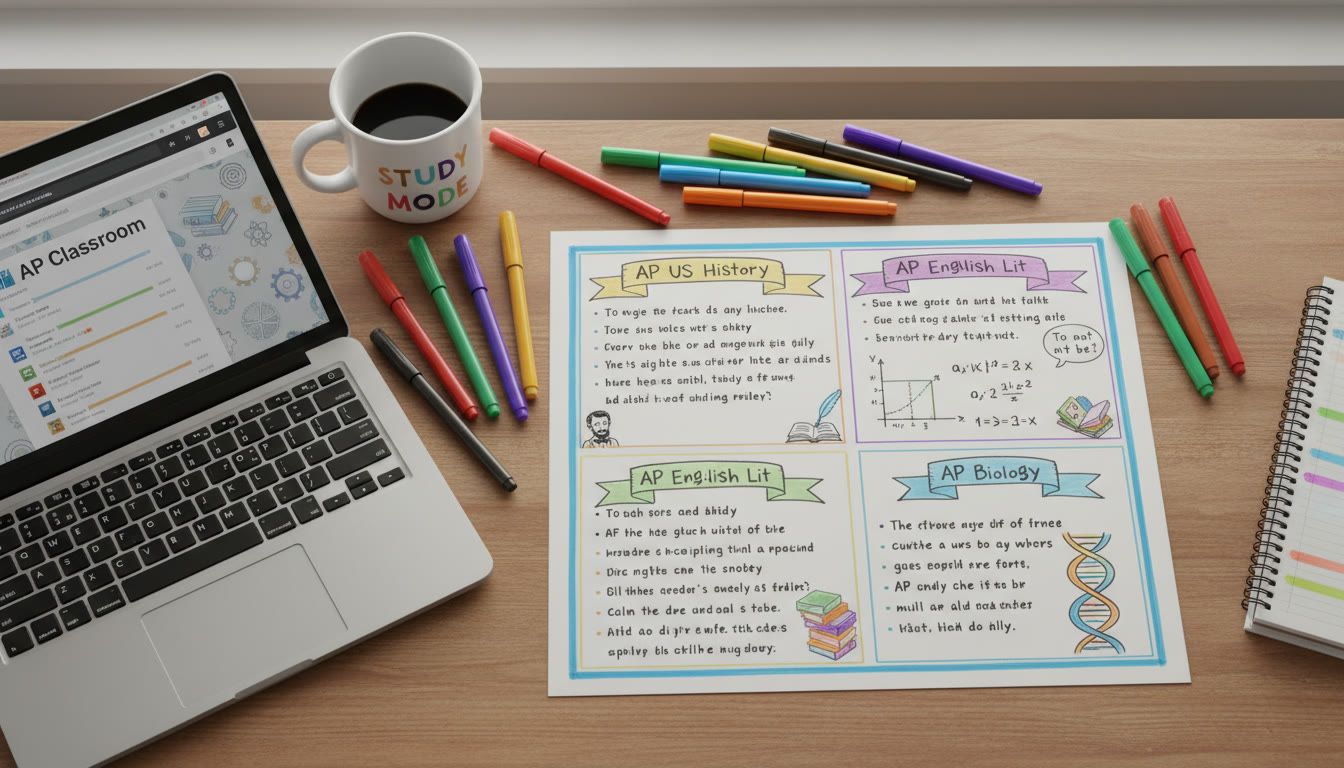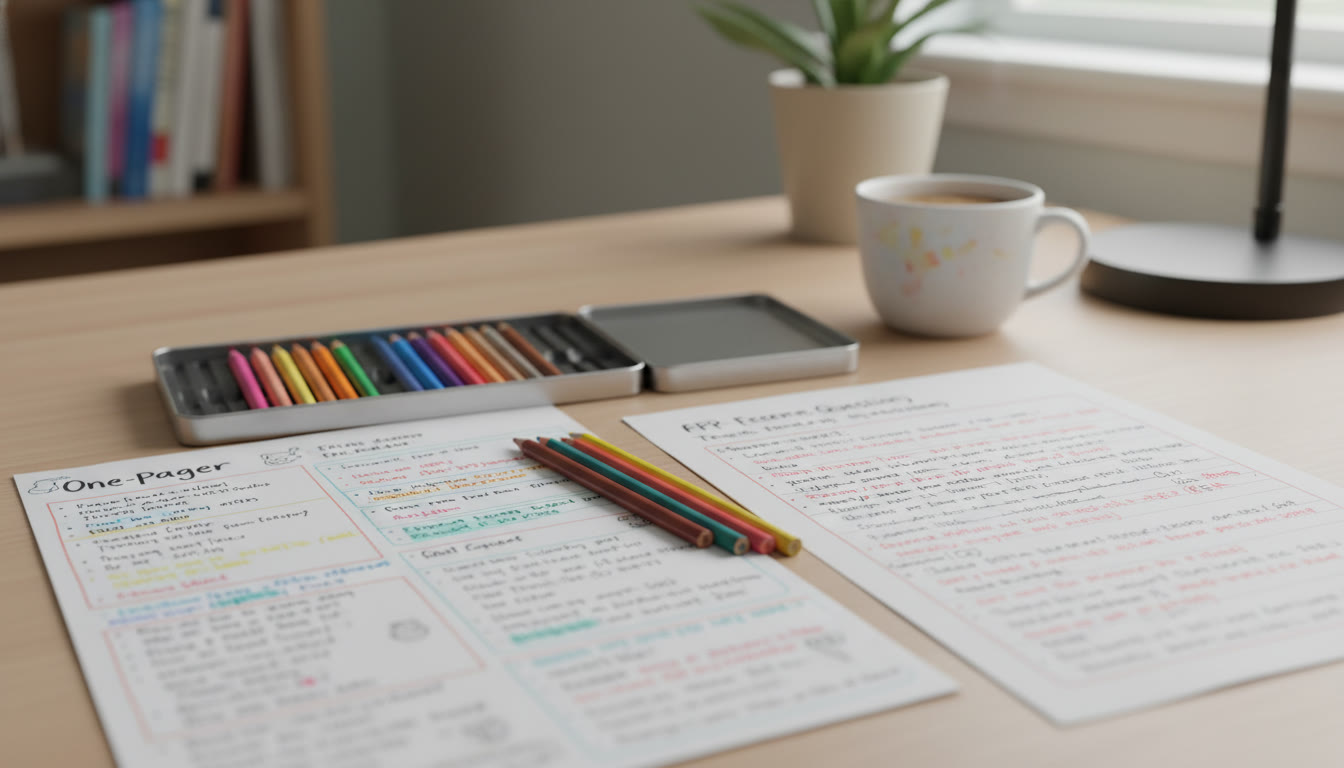Why One-Pagers Beat Page-Two-Hundred Panic: The Case for Compact AP Notes
Open your binder. Count the sticky notes. If your board notes look like tiny islands of information floating on a sea of lecture scribbles, you’re not alone. For AP students—balancing demanding syllabi, lab reports, essay practice, and extracurriculars—the real challenge is not collecting information but distilling it. That’s where the AP one-pager shines: a single, highly structured page that turns sprawling board notes into a strategic study tool you’ll actually use.

What a One-Pager Actually Does
A one-pager is not a reductionist trick to skip studying. It’s a synthesis tool: it surfaces patterns, prioritizes high-yield content, and creates a quick-access map of what you must remember for AP-style questions. When well-made, a one-pager helps with last-minute review, in-class recall, and even essay planning during the exam.
Think of it like a map legend: it doesn’t replace the map (your full notes) but tells you where to look and what matters most.
Before You Start: Prep Steps That Save Hours
Don’t dive straight into condensing. A short prep routine makes your one-pager faster and better.
- Set a 30–45 minute timer: Focused sprints produce clearer synthesis than long, distracted attempts.
- Gather source materials: board notes, textbook highlights, practice FRQs (Free-Response Questions), and any recent graded work.
- Identify the AP exam’s structure: units, topic weight, and common question types. If you’re unsure, consult your AP course outline or teacher’s syllabus to prioritize topics.
- Decide the purpose: quick daily review, pre-exam cram sheet, or an essay planning aid. The purpose shapes layout and content density.
Design Principles: How to Structure an AP One-Pager
Effective one-pagers follow a few simple rules so the brain can find what it needs fast.
- Hierarchy: Use headings, subheadings, and boxed sections. The most important facts belong in the top-left quadrant (your brain reads there first).
- Chunking: Group related ideas. For example, combine causes, effects, and examples under a single mini-header for history; or definitions, formulas, and sample problems for math/science.
- Visual anchors: Use icons, arrows, and short color codes (no need to be an artist—simple shapes work). Visual cues speed recall.
- One idea per line: Dense sentences are harder to scan. Keep entries short and punchy.
- Include exam cues: Add a tiny bracketed note like [MCQ], [FRQ], or [SAQ] near facts that frequently appear in specific AP question formats.
Suggested Layout (Portrait Single Page)
Here’s a flexible layout that works for most AP subjects:
- Top-left: Core Concepts & Definitions
- Top-right: High-Yield Dates/Formulas/Equations
- Middle: Visuals — timelines, reaction diagrams, political maps
- Bottom-left: Sample Evidence or Example Problems
- Bottom-right: Quick Strategies for MCQs and FRQs
Step-by-Step: Turning Board Notes Into a One-Pager
Follow this workflow every time you convert a unit.
Step 1 — Rapid Scan (10–15 minutes)
Read your board notes quickly and highlight (physically or mentally) terms that:
- appear multiple times
- are bolded or underlined in class handouts
- show up in past FRQs or sample multiple-choice stems
This rapid triage separates high-yield items from nice-to-know details.
Step 2 — Distill Into Categories (10–20 minutes)
Create 5–7 mini-categories that fit your subject. Examples:
- AP U.S. History: Causes, Key Events, People, Significance, Sample Evidence
- AP Biology: Definitions, Key Processes, Equations, Sample Graphs, Experiment Steps
- AP Literature: Themes, Characters, Important Quotes, Poetic Devices, Essay Hooks
Step 3 — Write, Then Edit Down (15–30 minutes)
Write full sentences or bullet notes first; then compress them. Replace long phrases with shorthand and symbols. For example: “Industrialization → urban migration → labor issues (strikes 1880s–1930s)”
Step 4 — Add Visuals and Exam Cues (10–15 minutes)
Draw a simple timeline, Venn diagram, chemical reaction arrow, or annotated graph. Then attach exam cues: [SAQ] next to quick evidence, [FRQ] beside thematic connections that support arguments.
Table: Example One-Pager Content by AP Subject
| AP Subject | Essential Sections on One-Pager | Sample Exam Cue |
|---|---|---|
| AP Chemistry | Formulas, Reaction Types, Rate Laws, Sample Problems, Common Units | [MCQ] Quick reaction identification |
| AP U.S. History | Key Dates, Turning Points, Primary Sources, Short Evidence Bullets | [FRQ] Use specific primary source evidence |
| AP Calculus AB | Theorems, Derivatives Rules, Integrals, Graph Shapes, Example Limits | [MCQ/FRQ] Sketch behavior near discontinuities |
| AP English Literature | Themes, Motifs, Character Traits, Quote Bank, Essay Outlines | [FRQ] Use a concise thesis + 3 pieces of textual evidence |
Examples and Mini Templates You Can Copy
Here are short, adaptable templates for three common AP scenarios. Use these as a starting point and make them your own.
Template A — History (Portrait)
- Top-left: 5 Key Terms (one line each)
- Top-right: Timeline of 6 Events (date — phrase — significance)
- Center: Primary source snippet + one sentence interpretation
- Bottom-left: Three FRQ sentence-starters
- Bottom-right: Quick exam strategy (how to use evidence under time pressure)
Template B — Science
- Top-left: Essential equations + units
- Top-right: Definitions & thresholds
- Center: Diagram (reaction, cycle, or graph) with numbered steps
- Bottom: One experimental setup and predicted result (good for lab questions)
Template C — English
- Top-left: Theme keywords
- Top-right: 6 short quotes with line numbers
- Center: Quick thesis formulas (2–3 options for different prompt types)
- Bottom: Language devices cheat sheet (metaphor, anaphora, enjambment) + example line
How to Use the One-Pager for Active Study
Paper one-pagers are a study weapon — only if you use them actively. Here are practical routines.
- Daily 5-minute check: Scan the top-left core concepts each morning to prime memory retention.
- Practice pairing: Cover half the page and try to reconstruct it from memory, then swap. This simulates recall under time pressure.
- Pre-essay warm-up: Keep a one-pager in your exam kit and use it in the first 5 minutes to find evidence and structure your thesis.
- Peer swap: Exchange one-pagers with a classmate. Their perspective will expose gaps or alternative organization methods.
Digital vs. Paper: Which Should You Choose?
Both have strengths. Paper aids memory through handwriting; digital allows quick edits, searchable text, and clean visuals.
- Paper: Better for kinesthetic learners and quick sketching. Carry a folded copy in your binder.
- Digital: Use for versions you’ll revise often, or to print multiple copies. Great for collaborative edits and color-coding without messy pens.
Many students do a hybrid: create a clean digital one-pager, print it, then annotate by hand during review sessions.
Common Mistakes and How to Avoid Them
- Too much detail: A one-pager that reads like a chapter defeats the purpose. Aim for anchors not essays.
- Poor organization: If you can’t find what you need in 10 seconds, reorganize. Test it under timed conditions.
- Not updating: One-pagers are living documents. After a practice exam, add the mistakes you made to the page.
- Relying only on one-pagers: They’re for review, not initial learning. Always couple them with deeper study.
How Sparkl’s Personalized Tutoring Can Fit Naturally Into Your One-Pager Workflow
If you feel stuck choosing what’s high-yield or how to structure your page, a short tutoring session can save hours and produce better results. Sparkl offers 1-on-1 guidance to:
- Help prioritize board notes into exam-focused sections.
- Create tailored study plans that tell you which one-pagers to build first.
- Provide expert tutors to review your one-pager drafts and recommend edits.
- Use AI-driven insights to highlight recurring question patterns you should emphasize.
Used sparingly, a focused Sparkl session can accelerate your learning curve and help you make one-pagers that actually improve scores.
Measuring Effectiveness: Quick Metrics to Track
To ensure your one-pager is working, keep simple metrics. Measure over a two-week study window.
- Recall Rate: Cover the page and try to reproduce it. Track percent recalled correctly.
- Error Reduction: Compare practice test mistakes before and after implementing one-pagers.
- Time to Answer: Time how long it takes to find evidence for an FRQ using the one-pager vs. using full notes.
Sample Progress Tracker Table
| Week | Recall Rate (Reconstruction) | Practice Score Before | Practice Score After | Notes/Changes |
|---|---|---|---|---|
| Week 1 | 60% | 72% | 78% | Added timeline and 3 FRQ sentence starters |
| Week 2 | 80% | 78% | 84% | Rewrote definitions for brevity; added sample graph |
Real-World Tips From Students Who Switched to One-Pagers
Here are distilled, practical habits students wish they’d learned sooner:
- Make one-pagers immediately after a unit test while the mistakes are fresh.
- Color-code by question type (e.g., green for multiple choice cues, purple for essay evidence).
- Keep a “common mistakes” corner — a tiny box listing errors you consistently make on practice problems.
- Bring a laminated copy to timed practice sessions to simulate test-like retrieval without risk of losing it.
Final Checklist Before Exam Week
- Every major unit has a corresponding one-pager.
- You can reconstruct each one-pager in under 10 minutes.
- Your one-pagers include at least one exam cue each (MCQ, FRQ, or SAQ).
- You reviewed each one-pager three times that week and updated two of them based on practice tests.
Closing Thoughts: Less Is Often More
Creating AP one-pagers is an act of intentional editing. It teaches you to value clarity over completeness and to recognize the patterns that AP exams reward—conceptual links, crisp evidence, and strategic application under time pressure. Done right, a single page can save you hours of anxiety and focus your studying on what actually moves the score needle.
And if you want a boost—whether it’s choosing which content to prioritize, polishing your layouts, or getting feedback on a draft—consider a targeted Sparkl session. A short, expert-guided review can turn a good one-pager into a great one in a single sitting.

Quick Start Action Plan (Do This Today)
- Pick one recent unit and set a 45-minute timer.
- Follow the Rapid Scan → Distill → Compress → Visualize steps above.
- Test recall immediately and mark one change to make tomorrow.
- If stuck, book a short Sparkl consultation focused on prioritizing content.
You’ve already done the hard part—collected the notes. The one-pager is simply the bridge from information to insight. Build it carefully, revise it often, and let it guide your practice problems. Over time, this compact habit will sharpen more than just your memory; it will sharpen how you think under pressure—exactly what AP exams measure.
Good luck—your future self (and your score report) will thank you.




















No Comments
Leave a comment Cancel